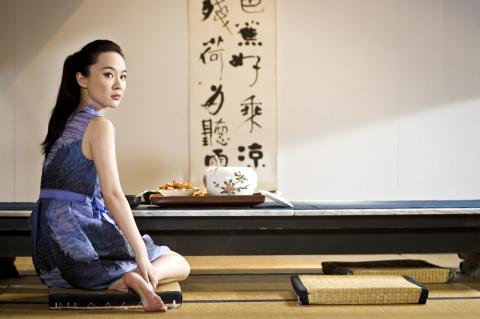Eighteen years after Ang Lee’s (李安) Eat Drink Man Woman (飲食男女) hit the big screen, the film’s producer Hsu Li-kong (徐立功) and award-winning television director Tsao Jui-yuan (曹瑞原) are releasing what’s billed as the sequel, Joyful Reunion (飲食男女—好遠又好近), which stars one of the original cast, Kui Ya-lei (歸亞蕾).
The film relies on the same concept of mixing food and human relationships, but content-wise it’s not sequel at all. The result, a narratively uneven tale about two families in China and Taiwan, delivered with a message of reunification, is nothing like Lee’s 1994 work, which explores familial relations and social reality.
In present-day Hangzhou, China, aging chef Tang Shizhe (Kenneth Tsang, 曾江) and his two daughters lead respectable and comfortable lives, thanks to the father’s prosperous vegetarian restaurant.

Photo courtesy of Activator Marketing Company
The elder daughter, Wa’er (Huo Siyan, 霍思燕), whose boyfriend, Chang Chuan (Blue Lan, 藍正龍), is a slightly nerdy computer game designer from Taipei, manages a luxury health resort.
One day Chang takes his aunt, Pai Ping (Kuei), who raised him like her own son, back to Hangzhou after a trip to Taipei.
To Ping, the Chinese city, which she grew up in and has not visited after fleeing to Taiwan during the Chinese Civil War, looks unrecognizable at first. But she soon settles into the luxurious surroundings at the resort where Wa’er works.
Meanwhile, Shizhe announces his plan to sell the restaurant because the chronic illness he suffers from is starting to take its toll. While agonized by her father’s condition, Wa’er is fed up with being neglected by Chang, who spends too much time in the virtual world, and decides to break up with him.
In an attempt to get the two back together, Pai phones Shizhe, who invites her to his restaurant for a feast. When the elders meet, memories come rushing back.
The film’s most glaring flaw is its structurally shaky screenplay, which was penned by six writers and two contributors, who are credited with “script coordination.”
While the movie’s most enjoyable moments are when the screen is dominated by Kui’s high-energy performance, she sometimes overdoes the comic delivery.
Anchored by Tsang’s quiet poise, Kui moves freely from a forthright, loud-mouthed waishengren (外省人, or person who fled to Taiwan after the Chinese Civil War) visiting The New China, to a woman reliving the emotions of her past life.
As the English title suggests, Joyful Reunion is more of a fairy-tale in which two generations learn to get along and live happily ever after. Whether the film is politically naive, or just a cynical ploy to tap China’s market, is up to the audience to decide.

This month the government ordered a one-year block of Xiaohongshu (小紅書) or Rednote, a Chinese social media platform with more than 3 million users in Taiwan. The government pointed to widespread fraud activity on the platform, along with cybersecurity failures. Officials said that they had reached out to the company and asked it to change. However, they received no response. The pro-China parties, the Chinese Nationalist Party (KMT) and Taiwan People’s Party (TPP), immediately swung into action, denouncing the ban as an attack on free speech. This “free speech” claim was then echoed by the People’s Republic of China (PRC),

Exceptions to the rule are sometimes revealing. For a brief few years, there was an emerging ideological split between the Democratic Progressive Party (DPP) and Chinese Nationalist Party (KMT) that appeared to be pushing the DPP in a direction that would be considered more liberal, and the KMT more conservative. In the previous column, “The KMT-DPP’s bureaucrat-led developmental state” (Dec. 11, page 12), we examined how Taiwan’s democratic system developed, and how both the two main parties largely accepted a similar consensus on how Taiwan should be run domestically and did not split along the left-right lines more familiar in

As I finally slid into the warm embrace of the hot, clifftop pool, it was a serene moment of reflection. The sound of the river reflected off the cave walls, the white of our camping lights reflected off the dark, shimmering surface of the water, and I reflected on how fortunate I was to be here. After all, the beautiful walk through narrow canyons that had brought us here had been inaccessible for five years — and will be again soon. The day had started at the Huisun Forest Area (惠蓀林場), at the end of Nantou County Route 80, north and east

Specialty sandwiches loaded with the contents of an entire charcuterie board, overflowing with sauces, creams and all manner of creative add-ons, is perhaps one of the biggest global food trends of this year. From London to New York, lines form down the block for mortadella, burrata, pistachio and more stuffed between slices of fresh sourdough, rye or focaccia. To try the trend in Taipei, Munchies Mafia is for sure the spot — could this be the best sandwich in town? Carlos from Spain and Sergio from Mexico opened this spot just seven months ago. The two met working in the